Skin problems of Dogs
Learn more about skin problems of dogs by exploring our site and become a true expert on the animal kingdom. You'll find content created for the best professionals with pictures, videos and opinions.
35 articles
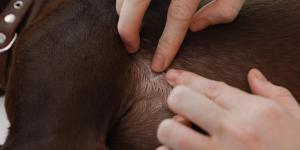
White spots on a dog's skin can appear almost anywhere. We might see one or more white spots on their nose, lip, ear, paw or even their tongue. Location is very important in helping a veterinarian determine the cause of the white spot, but there are other factors to consider. We also need to look at the...
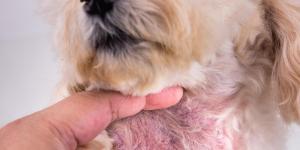
One of the first things we notice about a dog is the color of their fur, but the color of their skin is not always very noticeable. In fact, too many guardians pay insufficient attention to a dog's skin. When a problem develops which leads to symptoms such as flaking, redness, swelling or the presence...

It is normal for a dog to have an odor we find quite pungent. Especially if they are wet, the natural oils on their skin mix with bacteria and other microorganisms to create a strong smell. Some dogs naturally smell worse than others, whether due to skin type or their natural hormone production. Unfortunately,...

Is your dog developing a hard lump under its skin? While finding a lump on your dog can be concerning, not all bumps are harmful. However, as a pet parent, you want to ensure any unusual changes in your dog's body receive proper attention. Understanding the causes, recognizing symptoms, and knowing when...
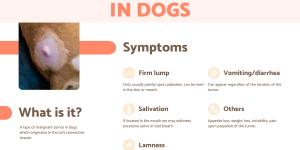
Various types of tumors can appear on our dog's body. Although they can be completely benign, the fear of a malignant tumor is a call to action to achieve a quick diagnosis. This is the case with canine fibrosarcoma, a malignant tumor that affects the soft connective tissues of their body. It is a result...

Some guardians wonder if it is possible for dogs to get dandruff. Although its exact cause is poorly understood, dandruff is a condition whereby dead skin cells accumulate on and around hair. Humans get dandruff on their scalp due the greater number of sebaceous glands which mix with the dead skin cells...

Melanoma, a type of cancer developing from pigment cells, lurks in the shadows for many dogs. While not always aggressive, it can be a serious threat, particularly when left undetected. Knowing the early signs of melanoma in dogs is crucial, as prompt diagnosis and treatment significantly improve their...

Also known as pyotraumatic dermatitis in dogs, acute moist dermatitis is a skin infection which results in oozing inflamed patches of skin known as hot spots. The skin is exposed due to the hair loss in the area, a hair loss which is caused by the dog themselves. When a dog licks the same area repeatedly...

Dermatitis in dogs is a term which refers to the inflammation of a dog's skin, a symptom which has many causes. Whether due to infection, sensitivity, parasites or any other issue, dermatitis can be very troubling for the dog. Not only does it cause discomfort and pain, but the damaged skin is made vulnerable...

Canine hepatocutaneous syndrome (HCS) is an uncommon metabolic disorder impacting both the liver and skin. It exhibits distinct characteristics such as hepatopathy, hypoaminoacidemia, aminoaciduria, and superficial necrolytic dermatitis (SND), leading to specific crusted, red, and histologically unique...

Cutaneous histiocytoma is a tumor that frequently occurs in young dogs less than 4 years of age. It is a tumor that appears in the form of reddish hairless nodules, generally in the head and neck area. Once they appear, the lesions grow rapidly, often causing great concern for caregivers. Despite their threatening...

Sebaceous cysts in dogs are benign lesions that frequently appear on the skin, especially in older animals. They are cavities surrounded by epithelium tissue that contains the fatty secretion of a sebaceous gland. Sebaceous cysts on dogs can look both painful and potentially harmful, but they are a...

Commonly known as puppy strangles, juvenile cellulitis is a disease that is characterized by producing severe inflammation of the skin and lymph nodes of dogs. It is a rare, immune-mediated disease of unknown origin. Despite our lack of understanding concerning its causes, there are effective treatments...

Black discharge from a dog's ear can appear seemingly out of nowhere. We often first see there is a problem by repeated scratching of the area, something which can exacerbate the problem by opening wounds or introducing secondary bacteria. The initial agitation is often due to otitis, a general term for...

A bump on a dog's ear is likely due to an issue known as otohematoma in dogs. A type of ear hematoma, it can greatly vary in size, shape and texture, according to the individual dog. Not only do dogs use their ears to hear, but they are very important in maintaining balance. Any pathologies or other...

It is difficult to overstate the importance of proper footcare in our dogs. The skin on the plantar area of the paw pads is both resistant and sensitive. As dogs move, their paws come in contact with the ground which can be of various textures and materials. The paw pad itself is made up of fatty tissue...

Wound healing is a process which is affected by various factors. A serious of macroscopic, microscopic and molecular events need to occur for a dog's wound to heal properly. Tissue regeneration is a marvelous process which helps organisms survive, but is often a more delicate process than we would like...

Calcinosis cutis is a disorder characterized by the lesions of calcium salts in the skin. The result is the appearance of hard nodules or crusted plaques. In the canine medicine, it usually appears in individuals with Cushing's syndrome or those subjected to prolonged treatment with corticosteroids. There...

While swelling and redness of a dog's paws can be observed at almost any stage, it is common for guardians to first become aware of this problem when we notice our dog keeps licking their paws. Whatever the underlying cause, swelling and redness is likely irritating for the dog. Licking their paws is a way...

Panniculitis is an inflammatory process that affects adipose tissue, the tissue we associate with body fat. It has multiple causes, both infectious and non-infectious. There are also many cases of idiopathic panniculitis in dogs where the etiology is unknown. The main clinical sign associated with panniculitis...
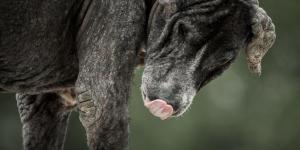
Ichthyosis is a skin disease that is known for its hardening of the skin. This seborrheic condition causes grey scales to appear, but it can result in secondary infections, blisters, onychogryphosis and hyperkeratosis.
It is a fortunately rare disease, but it does affect puppies more than adult dogs....

When your dog drags their butt against the floor, it can often be a very humorous sight. They sit down, raise their back legs and pull themselves along with their front paws. The pose they create and the often-strained face they make when doing so add to the picture. If this is a one-off experience, then...

We may not feel our dog's paws very often. Not only do we prefer to pet them on their fur, but generally dog's do not like their paws to be touched. However, it is very important we check on them regularly as injuries to their paws can cause pain, mobility issues and other problems. The skin on our...

Purple spots on a dog's ear can be sign that they are suffering from vasculitis in dogs. Canine Vasculitis is the inflammation of a dog's blood vessels. This pathology affects not only the skin of the dog, but in some cases, other organs too. Although vasculitis in dogs is easy to define, is very difficult...
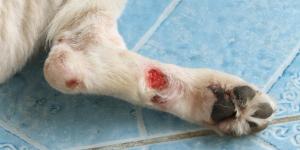
Skin diseases are one of the most frustrating pathologies for both dogs and their tutors. Apart from the obvious fact they jeopardize the health of the dog, they also reduce their quality of life. With sores, lesions, rashes and other symptoms of skin disease, the dog will often bite and scratch out of frustration....
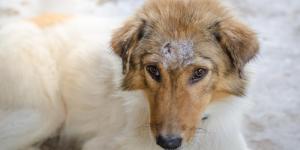
Knowing the different skin disease which affect dogs is an essential part of their care. Identifying changes to the condition of their skin can mean early signs of serious conditions are treated promptly. Observation of the dog's guardian is crucial as this is the way we can bring an issue to the attention...

Hives in dogs, also referred to as Urticaria, can be defined as visible bulges on skin, in addition to noticeable reddened skin inflammation. Have you noticed your dog scratching more than normal? This, in addition to a swollen face, are common symptoms of hives in dogs.
For more aboutthe causes, symptoms,...

Vitiligo in dogs is a rare condition with a relative lack of research in the area. Although not zoonotic or contagious, it is a skin condition which can also affect humans. Characterized by the development of white patches on the skin and hair, it is relatively uncommon. You might notice your dog gradually...

Canine folliculitis is an infection of the hair follicles that usually occurs as a consequence of another skin disease. This dermatological disease directly affects a dog’s hair follicle health. Folliculitis in dogs is an infection that can appear in animals of all ages, but is more common in puppies...

Abscesses in dogs are caused by the accumulation of pus in various tissues in a dog's body. They are often the result of infection, but they can also be caused by other inflammatory processes. While they often appear under the skin, they can create a fistula which extends to break through it. These are...

Malassezia is a genus of fungi, a yeast that is usually found in human and animal skin surfaces. Malassezia pachydermatitis is the most common type of malassezia found on both dogs and cats. Normally, these yeasts do not cause any harm. However, malassezia infections can occur when the number of malassezia...

When we think of pimples, we might have the stereotype of an oily teenager with acne in mind. Dog acne isn't something we necessarily associate with dogs. This is partly because they are covered in fur and we might not even think to check their skin underneath. This is a common mistake guardians make with...
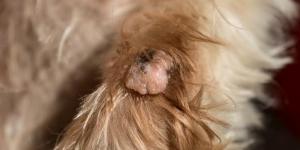
Warts on dogs can appear relatively frequently, especially as the dog ages. Warts are characterized as benign superficial tumors which usually do not have any serious ramifications for canine health. We do need to be careful as there can be complications if the dog's wart starts bleeding. The warts may...
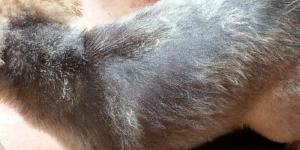
There are different reasons a dog may have black skin, some of which should be concerning. This is the case when it a symptom of an underlying condition. This can be a hormonal imbalance which is causing changes in their physicality and likely their behavior. It is also important to remember that black...

Dogs can sometimes experience skin irritation which can appear as red or itchy areas on the skin. This irritation can cause severe discomfort for our canines. Skin irritation is dogs is known as dermatitis. The causes for skin problems in dogs can vary, therefore, if you notice that your dog is experiencing...
